A Brief introduction of SUZHOU
 The historic city of Suzhou is a place of astonishing beauty,
located roughly
an hours’drive (by bus or 40minutes by train) from Shanghai. Famous for its classical gardens
which are listed as a UNESCO World Heritage site, Suzhou is a top daytrip
destination from Shanghai.
The historic city of Suzhou is a place of astonishing beauty,
located roughly
an hours’drive (by bus or 40minutes by train) from Shanghai. Famous for its classical gardens
which are listed as a UNESCO World Heritage site, Suzhou is a top daytrip
destination from Shanghai.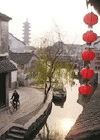 Laid out in a grid of tree-lined streets and intersecting canals, Suzhou has
long been seen as a city of artists, scholars and affluent merchants. The old
quarter is hemmed in by a protective moat measuring two by three miles, and to a
great extent the city has retained its historic charm.
Laid out in a grid of tree-lined streets and intersecting canals, Suzhou has
long been seen as a city of artists, scholars and affluent merchants. The old
quarter is hemmed in by a protective moat measuring two by three miles, and to a
great extent the city has retained its historic charm. A product of numerous invasions and rebuilding campaigns,
 Suzhou seems to have
relics from every age and dynasty of China’s impressive history, making this a
top-priority destination both for domestic and international visitors. Ancient
sites like Pan Men Gate and the leaning Yunyan Pagoda are extremely popular
tourist attractions.
Suzhou seems to have
relics from every age and dynasty of China’s impressive history, making this a
top-priority destination both for domestic and international visitors. Ancient
sites like Pan Men Gate and the leaning Yunyan Pagoda are extremely popular
tourist attractions.Above all, visitors enjoy the tranquillity of Suzhou’s private gardens, of which there are more than 70 in all. Though the gardens suffered severely during the Cultural Revolution, the private owners have gone to great lengths to restore these sanctuaries to their original, evocative state. Arranged in ever-tightening, slightly concentric patterns, these gardens foster a mystic retreat into the self. Locals prize them for their reflective and contemplative effect.
Suzhou’s marketplaces teem with shoppers seeking famous Suzhou silk,
 spun and
woven on looms throughout the city. Master artisans can embroider two sides of
the same sheet of silk with intricate designs that seem impossibly conjoined.
Meanwhile, the sweet-smelling breeze generated by Suzhou’s aromatic sandalwood
fans has both cooled and soothed locals for centuries.
spun and
woven on looms throughout the city. Master artisans can embroider two sides of
the same sheet of silk with intricate designs that seem impossibly conjoined.
Meanwhile, the sweet-smelling breeze generated by Suzhou’s aromatic sandalwood
fans has both cooled and soothed locals for centuries. Accommodation is available throughout the old and new sectors of town. Many tourists prefer to stay along the canals in the heart of the old city, within easy walking or boating distance of the most popular gardens and attractions. Most of the upscale hotels offer excellent dining facilities that serve local and international cuisines.
The ancient city of Suzhou is a success story of China’s burgeoning modern age.
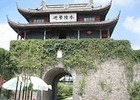 City officials have banned high-rises from the city centre, such that that old
city retains its ancient charm while newer suburbs facilitate modern industries
and prosperity for locals. The city lives up to its reputation as China’s Garden
City. Canals, ancient architecture and green spaces give the city a timeless and
tranquil ambiance.
City officials have banned high-rises from the city centre, such that that old
city retains its ancient charm while newer suburbs facilitate modern industries
and prosperity for locals. The city lives up to its reputation as China’s Garden
City. Canals, ancient architecture and green spaces give the city a timeless and
tranquil ambiance.History of Suzhou
Suzhou’s history reaches back thousands of years to the Wu culture which
developed 2,500 years ago on the Yangtze River basin under the patronage of the
Shang Dynasty. The city itself was officially founded by King He Lu in 514 BC
during a feudal stage of Chinese history known as the ‘Spring and Autumn
Period’.
With King He Lu as Suzhou’s great patriarch,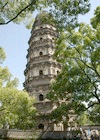 the city went on to immortalise him
by burying his remains (along with a bounty of 3,000 swords) at an undisclosed
location on Tiger Hill. Throughout the coming centuries, stories of the king and
his burial attained mythic proportions, driving treasure hunters and even
emperors to scour Tiger Hill for the swords.
the city went on to immortalise him
by burying his remains (along with a bounty of 3,000 swords) at an undisclosed
location on Tiger Hill. Throughout the coming centuries, stories of the king and
his burial attained mythic proportions, driving treasure hunters and even
emperors to scour Tiger Hill for the swords.
Suzhou enjoyed an early, though brief, Golden Age that ended with invasion of the Yue Kingdom from the east in 473 BC. However, remnants of the original kingdom remain to this day. Pan’s Gate is the most prominent such relic.
The rise and fall of several regional dynasties influenced Suzhou through the
coming centuries. The name ‘Suzhou’ was officially bestowed on the city (it was
previously named after its patriarch) in 589 AD when the Sui Dynasty was in
control. The Grand Canal was built soon after and Suzhou became a strategic
trading point along the Yangtze, offering access to the coast.
influenced Suzhou through the
coming centuries. The name ‘Suzhou’ was officially bestowed on the city (it was
previously named after its patriarch) in 589 AD when the Sui Dynasty was in
control. The Grand Canal was built soon after and Suzhou became a strategic
trading point along the Yangtze, offering access to the coast.
Status as a trading hub bolstered the arts and industries of Suzhou. The Yunyan Pagoda and the Temple of Confucius were both finished around the turn of the 11th century. Two more invasions followed in the 12th and 13th centuries, by the Jin and Mongol armies respectively. The city centre was badly damaged as a result of the latter.
The famous classical gardens (now a UNESCO World Heritage site)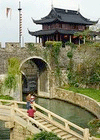 were constructed
in the coming centuries, which were characterised by greater peace and
prosperity. Many of these were (and continue to be) privately owned and
operated. Tragically, several historic gardens were badly damaged during the
Japanese invasion of 1937, and intense restoration projects followed WWII.
were constructed
in the coming centuries, which were characterised by greater peace and
prosperity. Many of these were (and continue to be) privately owned and
operated. Tragically, several historic gardens were badly damaged during the
Japanese invasion of 1937, and intense restoration projects followed WWII.
In the 1980s, the State Council put a priority on the preservation on Suzhou’s historical infrastructure and unique culture. As a result, the city has grown into a popular destination among Chinese and international tourists.
With King He Lu as Suzhou’s great patriarch,
 the city went on to immortalise him
by burying his remains (along with a bounty of 3,000 swords) at an undisclosed
location on Tiger Hill. Throughout the coming centuries, stories of the king and
his burial attained mythic proportions, driving treasure hunters and even
emperors to scour Tiger Hill for the swords.
the city went on to immortalise him
by burying his remains (along with a bounty of 3,000 swords) at an undisclosed
location on Tiger Hill. Throughout the coming centuries, stories of the king and
his burial attained mythic proportions, driving treasure hunters and even
emperors to scour Tiger Hill for the swords. Suzhou enjoyed an early, though brief, Golden Age that ended with invasion of the Yue Kingdom from the east in 473 BC. However, remnants of the original kingdom remain to this day. Pan’s Gate is the most prominent such relic.
The rise and fall of several regional dynasties
 influenced Suzhou through the
coming centuries. The name ‘Suzhou’ was officially bestowed on the city (it was
previously named after its patriarch) in 589 AD when the Sui Dynasty was in
control. The Grand Canal was built soon after and Suzhou became a strategic
trading point along the Yangtze, offering access to the coast.
influenced Suzhou through the
coming centuries. The name ‘Suzhou’ was officially bestowed on the city (it was
previously named after its patriarch) in 589 AD when the Sui Dynasty was in
control. The Grand Canal was built soon after and Suzhou became a strategic
trading point along the Yangtze, offering access to the coast.Status as a trading hub bolstered the arts and industries of Suzhou. The Yunyan Pagoda and the Temple of Confucius were both finished around the turn of the 11th century. Two more invasions followed in the 12th and 13th centuries, by the Jin and Mongol armies respectively. The city centre was badly damaged as a result of the latter.
The famous classical gardens (now a UNESCO World Heritage site)
 were constructed
in the coming centuries, which were characterised by greater peace and
prosperity. Many of these were (and continue to be) privately owned and
operated. Tragically, several historic gardens were badly damaged during the
Japanese invasion of 1937, and intense restoration projects followed WWII.
were constructed
in the coming centuries, which were characterised by greater peace and
prosperity. Many of these were (and continue to be) privately owned and
operated. Tragically, several historic gardens were badly damaged during the
Japanese invasion of 1937, and intense restoration projects followed WWII.In the 1980s, the State Council put a priority on the preservation on Suzhou’s historical infrastructure and unique culture. As a result, the city has grown into a popular destination among Chinese and international tourists.
Today's Suzhou
Not just for its natural beauty,
 its splendid history, or its cultural heritage,
Suzhou’s economy represents the highest growth and the fastest expansion in the
past 5-10 years in the region and in China. The city’ GDP has surpassed its any
other neighbor cities except Shanghai in the region, and more than 80 of the
world top 500 corporations listed on the Fortune have set their offices in the
town.
its splendid history, or its cultural heritage,
Suzhou’s economy represents the highest growth and the fastest expansion in the
past 5-10 years in the region and in China. The city’ GDP has surpassed its any
other neighbor cities except Shanghai in the region, and more than 80 of the
world top 500 corporations listed on the Fortune have set their offices in the
town.

suzhou is one of thirteen prefecture cities of Jiangsu and the cities including Changshu, Taicang, Kunshan, Wujiang and Zhangjiagang are under its jurisdiction. The flower emblematic of the city is osmanthus and the city tree is camphor laurel.
 its splendid history, or its cultural heritage,
Suzhou’s economy represents the highest growth and the fastest expansion in the
past 5-10 years in the region and in China. The city’ GDP has surpassed its any
other neighbor cities except Shanghai in the region, and more than 80 of the
world top 500 corporations listed on the Fortune have set their offices in the
town.
its splendid history, or its cultural heritage,
Suzhou’s economy represents the highest growth and the fastest expansion in the
past 5-10 years in the region and in China. The city’ GDP has surpassed its any
other neighbor cities except Shanghai in the region, and more than 80 of the
world top 500 corporations listed on the Fortune have set their offices in the
town.
suzhou is one of thirteen prefecture cities of Jiangsu and the cities including Changshu, Taicang, Kunshan, Wujiang and Zhangjiagang are under its jurisdiction. The flower emblematic of the city is osmanthus and the city tree is camphor laurel.
Weather in Suzhou
Suzhou’s climate is classified as subtropical monsoon and the city experiences
four distinct seasons including relatively mild winters and wet, balmy summers.
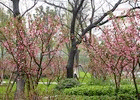 Rainfall begins to increase in March, though it picks up even more between the
months of June and September. During this rainy season, average daytime highs
exceed 30°C, while overnight lows settle in at around 25°C. The best time to
visit is from September to November, when temperatures are pleasant and rainfall
is less frequent.
Rainfall begins to increase in March, though it picks up even more between the
months of June and September. During this rainy season, average daytime highs
exceed 30°C, while overnight lows settle in at around 25°C. The best time to
visit is from September to November, when temperatures are pleasant and rainfall
is less frequent.
The weather becomes drier during October and continues to remain this way through February. During these months, average daytime highs drop to their lowest point of just below 10°C, while lows dip to near-freezing temperatures after dark. This is Suzhou’s low season, as cool temperatures discourage people from spending much time in the gardens. Keep in mind that Suzhou is a relatively humid place and rain continues to fall in every season. Snowfall is a rarity.
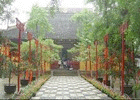 During the spring months of March and April, flowers begin to bloom. While
formal flower arrangements are not a trademark of the classical gardens, the
city features an increasing number of potted flower arrangements in places like
Tiger Hill. These are at their best during these months.
During the spring months of March and April, flowers begin to bloom. While
formal flower arrangements are not a trademark of the classical gardens, the
city features an increasing number of potted flower arrangements in places like
Tiger Hill. These are at their best during these months.
 Rainfall begins to increase in March, though it picks up even more between the
months of June and September. During this rainy season, average daytime highs
exceed 30°C, while overnight lows settle in at around 25°C. The best time to
visit is from September to November, when temperatures are pleasant and rainfall
is less frequent.
Rainfall begins to increase in March, though it picks up even more between the
months of June and September. During this rainy season, average daytime highs
exceed 30°C, while overnight lows settle in at around 25°C. The best time to
visit is from September to November, when temperatures are pleasant and rainfall
is less frequent.The weather becomes drier during October and continues to remain this way through February. During these months, average daytime highs drop to their lowest point of just below 10°C, while lows dip to near-freezing temperatures after dark. This is Suzhou’s low season, as cool temperatures discourage people from spending much time in the gardens. Keep in mind that Suzhou is a relatively humid place and rain continues to fall in every season. Snowfall is a rarity.
 During the spring months of March and April, flowers begin to bloom. While
formal flower arrangements are not a trademark of the classical gardens, the
city features an increasing number of potted flower arrangements in places like
Tiger Hill. These are at their best during these months.
During the spring months of March and April, flowers begin to bloom. While
formal flower arrangements are not a trademark of the classical gardens, the
city features an increasing number of potted flower arrangements in places like
Tiger Hill. These are at their best during these months.Contact Us
Shop Fittings
- Retail Shelving series
- Shop Shelving Euro
- Metal Gondola Shelf
- Wire Shelving Metro
- Shopping Trolleys
- Shopping Baskets
- Checkout Counters
- Promotion Tables
- Garment Rack & Rails
- Vegetable Fruit Rack
- Display Stands
- Metal Display Parts
- POP Display System
- Slatwall Display System
- Acrylic Display Fixtures
- Display Showcases
- Refrigeration Freezer
- Barrier Post System
- Shop Equipment
- Material Handling
- New Shop Fittings
